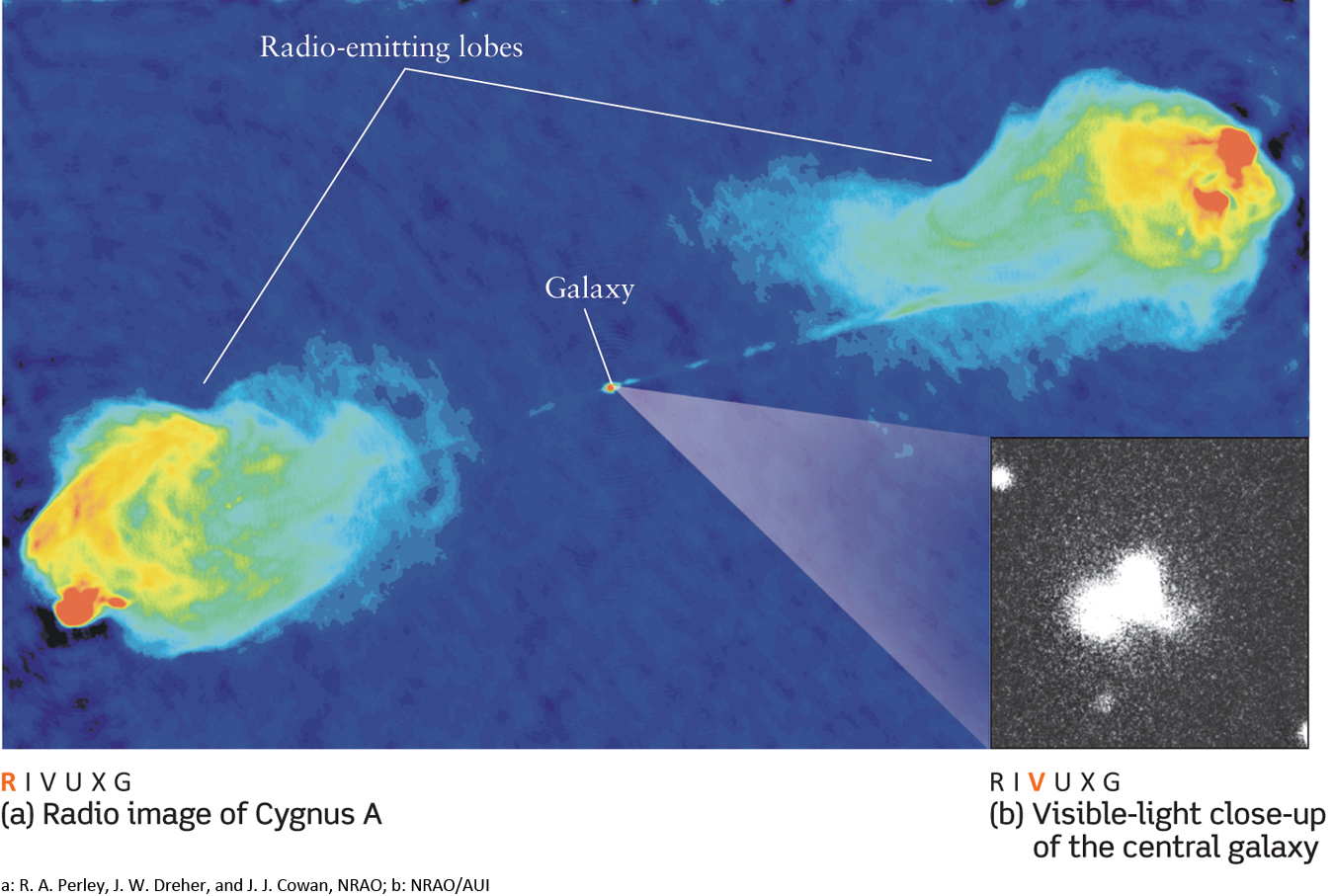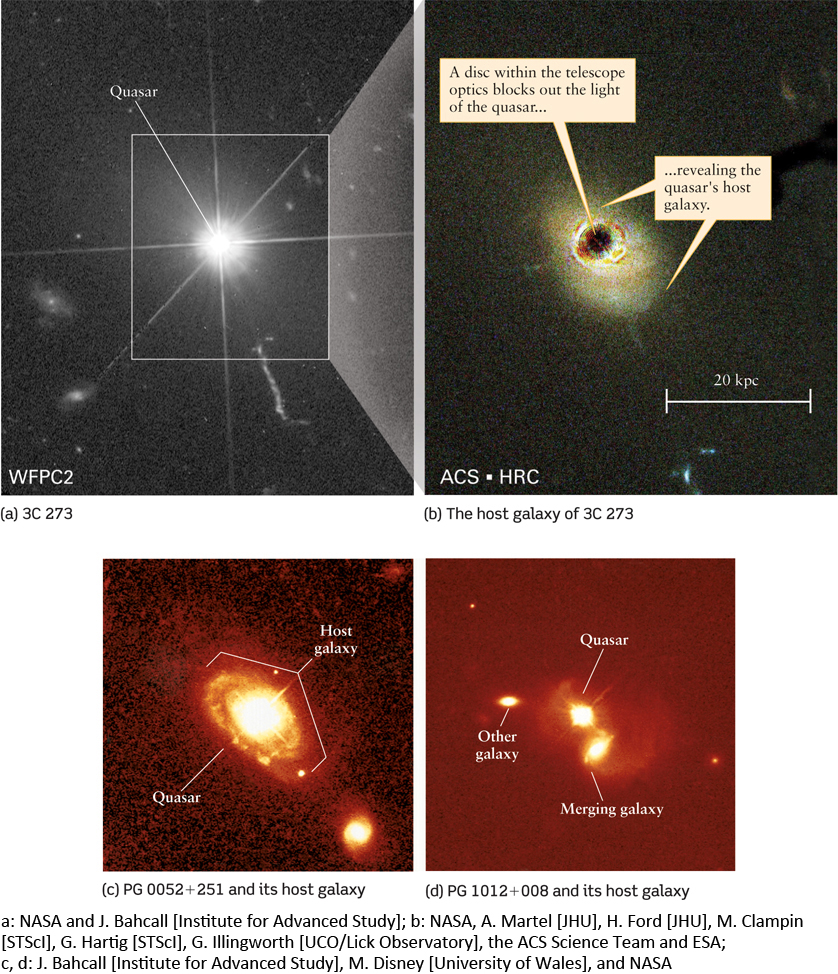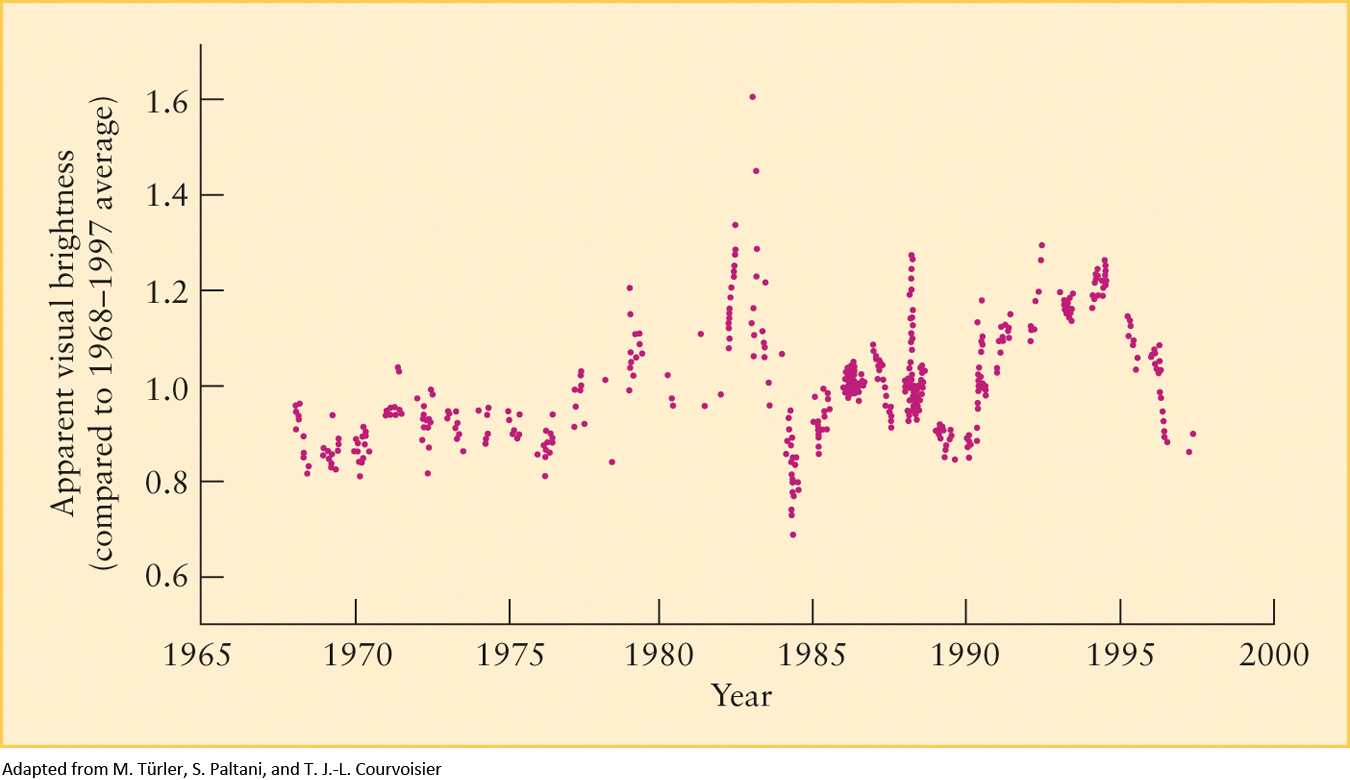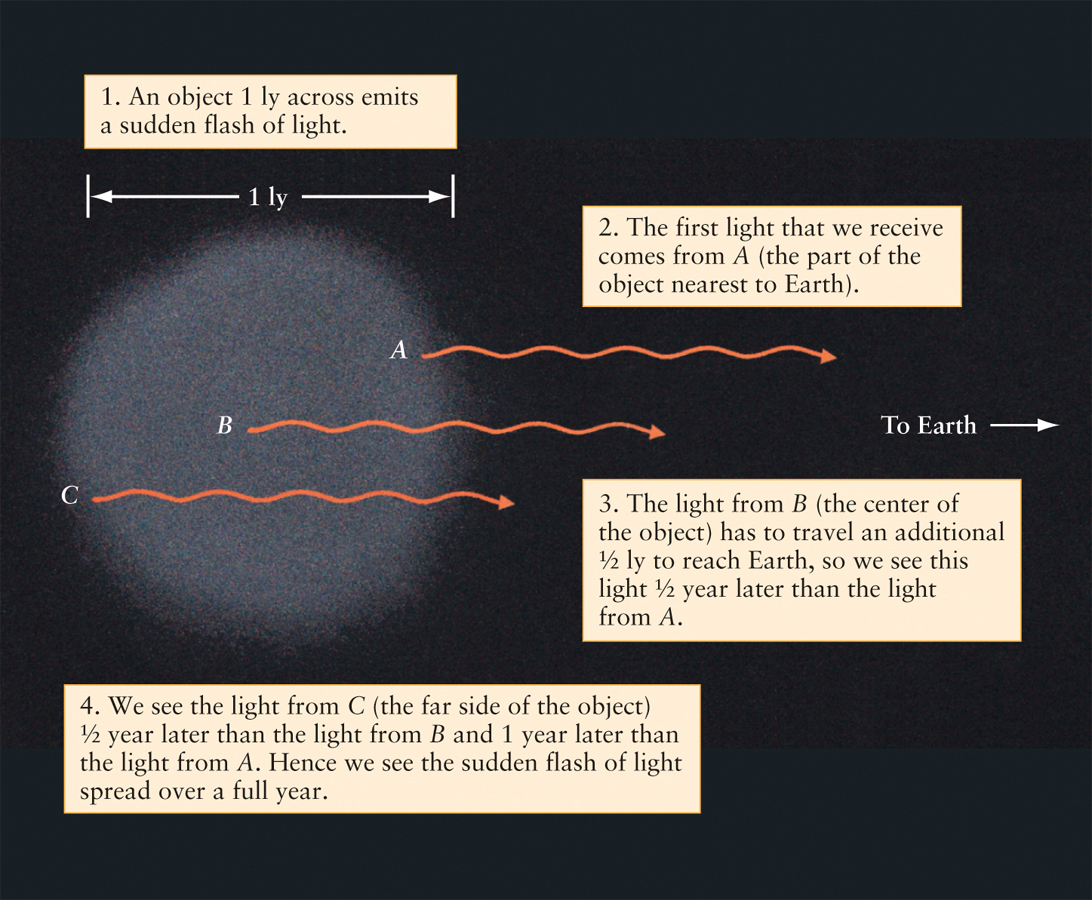14-7 Quasars are the ultraluminous centers of the most distant galaxies
Grote Reber, a radio engineer and ham radio enthusiast, built the first true radio telescope in 1936 in his backyard in Illinois. By 1944, he had detected three strong radio emissions coming from the general directions of the constellations Cassiopeia, Sagittarius, and Cygnus.
Two of these heavenly sources of radio waves, named Cassiopeia A and Sagittarius A, happen to lie in our own Galaxy; these two different sources are the remains of an exploded star and, much farther away, a mysterious source at the center of the Galaxy. The nature of the third source, called Cygnus A (Figure 14-29a), proved more elusive. The mystery only deepened in 1951, when Walter Baade and Rudolph Minkowski used the 200-in. (5-m) optical telescope on Palomar Mountain to discover a dim, strange-looking galaxy at the position of the Cygnus A radio wave source (Figure 14-29b).

When Baade and Minkowski photographed the spectrum of Cygnus A, they were surprised to find a number of bright emission lines. This was wholly unexpected because a normal galaxy shows absorption lines in its spectrum. This typically observed absorption takes place in the atmospheres of the individual stars that make up the galaxy. In order for Cygnus A to have emission lines, something must be exciting and ionizing its atoms. Furthermore, the wavelengths of Cygnus A’s emission lines are all shifted by 5.6% toward the red end of the spectrum. This corresponds to a tremendous distance from Earth—about 740 million ly. Yet despite its tremendous distance from Earth, radio waves from Cygnus A can be picked up by amateur astronomers with the simplest of backyard equipment. This means that Cygnus A must be one of the most luminous radio sources in the sky. In fact, its radio luminosity is 107 times as great as that of an ordinary galaxy like the Milky Way. The object that creates the Cygnus A radio emission must be something quite extraordinary.
347
Cygnus A was not the only curious radio source to draw the attention of astronomers. In 1960, Allan Sandage used the 200-inch telescope at Palomar to discover a “star” at the location of a radio source designated 3C 48. (The 3C refers to the Third Cambridge Catalogue, a compendium of radio sources.) Ordinary stars are not strong sources of radio emission, so 3C 48 must be something unusual.
Although 3C 48 and 3C 273 were clearly oddballs, many astronomers thought they were just strange stars in our Galaxy. A breakthrough occurred in 1963, when Maarten Schmidt at Caltech took a more careful look at the spectrum of 3C 273. Schmidt determined that 3C 273 has a recessional velocity of 100,000 miles per hour, nearly 15% of the speed of light. No star could be moving this fast and remain within our Galaxy for very long. Hence, Schmidt concluded that 3C 273 could not be a nearby star, but must lie outside the Milky Way. To be detected at such distances, 3C 273 must be an extraordinarily powerful source of both visible and radio light.
Because of their strong radio emission and starlike appearance, 3C 48 and 3C 273 were dubbed quasi-stellar radio sources, a term soon shortened to quasars. After the first quasars were discovered by their radio emission, many similar ultradistant, starlike objects were found that emit little or no radio wavelength light. These “radio-quiet” quasars were originally called quasi-stellar objects, or QSOs, to distinguish them from radio emitters. Today, however, the term “quasar” is often used to include both types.
Question
ConceptCheck 14-15: What makes Cassiopeia A and Sagittarius A so unusual?
Quasars Are the Ultraluminous Centers of Distant Galaxies
What are these strange, brilliant, and distant objects? Quasars cannot simply be very large and luminous galaxies, because their spectra are totally different. Quasars turn out to be ultraluminous objects located at the centers of remote galaxies.
In the 1970s, observations showed that quasars are associated with some of the most remote galaxies. Long-exposure images of quasars showed that they are often found in groups or clusters of galaxies, and that the distance to these quasars is essentially the same as the distances to the galaxies that surround them. A quasar’s spectra can indicate its distance from Earth, as do the distances of galaxies.
It is very difficult to observe the “host galaxy” in which a quasar is located because the quasar’s light overwhelms light from the galaxy’s individual stars (Figure 14-30a). Nevertheless, improved technology and painstaking observations have revealed some basic properties of these host galaxies (Figure 14-30b). Relatively nearby radio-quiet quasars tend to be located in spiral galaxies, whereas radio-loud quasars as well as more distant radio-quiet quasars tend to be located in ellipticals (Figure 14-30c). However, a large percentage of these host galaxies have distorted shapes or are otherwise peculiar. Many have nearby companion galaxies, suggesting a link between collisions or mergers and the quasar itself (Figure 14-30d). While observations like those in Figure 14-30 show that quasars lie at the centers of galaxies, they do not really explain what quasars are.

348
Question
CalculationCheck 14-1: If two quasars have identical energy output, but one is 3 times farther from us than the other, what is the difference in brightness as seen from Earth?
Active Galaxies and AGNs
Quasars are members of a diverse group of very distant, super-luminous objects now collectively known as active galaxies The activity of such a galaxy comes from an energy source at its center. Hence, astronomers say that these galaxies possess active galactic nuclei, or AGNs.
One of the features that distinguishes one type of AGN from another is the width of the emission lines in their spectra. The widths of these emission lines indicate that individual light-emitting gas clouds are moving within the quasar at very high speeds (around 20 million miles per hour or 9000 km/s). Some of the clouds are moving toward us, causing the emitted light to have a shorter wavelength and higher frequency, while other clouds are moving away from us and emit light with longer wavelength and lower frequency.
349
One characteristic that is common to all types of active galactic nuclei is variability. For example, Figure 14-31 shows brightness fluctuations of the quasar 3C 273 as determined from 29 years of observations. The brightness of 3C 273 increased by 60% from the beginning to the end of 1982, then declined to the starting value in just five months. Other AGNs undergo greater fluctuations in brightness (by a factor of 25 or more) that occur even more rapidly (X-ray observations reveal that some objects vary in brightness over time intervals as short as 3 hours).

These fluctuations in brightness allow astronomers to place strict limits on the maximum size of a light source. An object cannot vary in brightness faster than light can travel across that object. For example, an object that is 1 ly in diameter cannot vary significantly in brightness over a period of less than 1 year.
To understand this limitation, imagine an object that measures 1 ly across, as in Figure 14-32. Suppose the entire object emits a brief flash of light. Photons from that part of the object nearest Earth arrive at our telescopes first. Photons from the middle of the object arrive at Earth 6 months later. Finally, light from the far side of the object arrives a year after the first photons. Although the object emitted a sudden flash of light, we observe a gradual increase in brightness that lasts a full year. In other words, the flash is stretched out over an interval equal to the difference in the light travel time between the nearest and farthest observable regions of the object.

350
The rapid flickering exhibited by active galactic nuclei means that they emit their energy from a small volume, possibly less than 1 light-day across. In other words, a region no larger than our solar system can emit more energy per second than a thousand galaxies! Astrophysicists therefore face the challenge of explaining how so much energy can be produced in such a very small volume.
Question
ConceptCheck 14-16: Why do astronomers think the energy source of an AGN has a relatively small diameter?